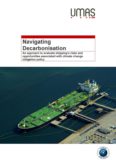Today, Carbon War Room (CWR) and UMAS released research that suggests climate transition pathways pose risks to the banks that hold $400 billion of global shipping debt. With the onset of climate policies as soon as 2023, there will be a need for significant capital investment to keep vessels competitive. Navigating Decarbonisation: An approach to evaluate shipping’s risks and opportunities associated with climate change mitigation policy lays out the first approach to climate stress-testing of shipping assets and proposes that enhanced due-diligence undertaken today by financiers, shipowners, and shareholders can help deliver long-term value and avoid losses by the mid-2020s.
By examining outcomes of investment approaches in a range of future scenarios in the newbuild drybulk fleet (60,000–99,999 dwt), the research assesses whether the industry is exposed to climate policy-driven risks and how to manage these risks. This is the first known scenario analysis of decarbonisation risks in shipping. Project finance and corporate lending to the international shipping industry has long been big business for major financial institutions. The 18-month project identified that while some financial stakeholders are aware of stranded asset risks, few banks assess ship efficiency or have lending programmes in place to keep assets competitive.
Jules Kortenhorst, CEO, Carbon War Room and Rocky Mountain Institute commented: “This is not an easy time for shipping finance. However decarbonisation can still be a win-win on profit and climate for shipping desks, but they will have to be more proactive and live up to the green reputation that many of their institutions hold.
“Financiers should be future-proofing investments and preparing to harness the new opportunities decarbonisation will create. Even with $400 billion in global shipping debt at stake, we have little evidence this is happening. We’ve taken the first step.”
Navigating Decarbonisation is the third instalment of research on stranded assets and climate risk in shipping from CWR and UMAS. It offers a method to analyse how GHG mitigation policies in shipping and national contributions under the Paris Agreement could impact existing and future investments in shipping.
James Mitchell, senior associate for shipping with Carbon War Room, explains: “Risk is nothing new to the shipping industry or to the major financial institutions that bankroll it, but climate transition risk is. If a newbuild financing decision is made today, that vessel will very probably have to compete under new IMO or EU policy actions before its first drydock. This work suggests that these risks will impact the market and should be considered now.
“We recognise the challenges faced today. Markets are weak, capital requirements are increasing, and compliance with upcoming regulations will require significant capital investment. However, actions taken now by financiers, owners, and shareholders will position both individual assets and the industry as a whole for greater long-term profitability, and will ensure that the first step of decarbonisation is a success. We look forward to working with the industry’s leaders to understand the risks and unlock the opportunities of decarbonisation.”
Dr Tristan Smith, Director, UMAS, explains: “Future regulation on shipping GHG is now certain. It’s just the velocity and stringency that remain unknown, and we can handle this by thinking in terms of scenarios. This collaboration has given us an excellent opportunity to further think about how techno-economic modelling can help to identify risks and opportunities to different scenarios and has given us many ideas for our ongoing work.
“The key takeaway from the report is for financiers and shipowers to be prepared and thus it is crucial to future-proof assets now and plan for flexibility from the onset, through for example, designing for future retrofits and using innovative financing mechanisms to deal with a variety of future scenarios. Scenario analysis that combines an integrated techno-economic assessment with a number of foreseeable policy scenarios can help navigate future uncertainties and help financiers and shipowners make more informed decisions about their assets.







